child seat OLDSMOBILE SILHOUETTE 1996 Owners Manual
[x] Cancel search | Manufacturer: OLDSMOBILE, Model Year: 1996, Model line: SILHOUETTE, Model: OLDSMOBILE SILHOUETTE 1996Pages: 372, PDF Size: 19.39 MB
Page 13 of 372

Remova ~ Rear Bucket Seats
SEAT LOCATION
There are three types of rear bucket seats: RIGHT
ONLY, CENTER OR LEFT and LEFT ONLY. RIGHT
ONLY and LEFT ONLY seats may be equipped with the
built-in child restraint option. The
rear bucket seats can be removed to provide extra
storage. Each seat that has the built-in child restraint
option fits in ’only one location in your vehicle. Seats
that don’t have the built-in child restraint can
be moved
to different floor locations. The back of each seat has a
diagram (similar to the one pictured) that shows where
the seat must
be located in your vehicle.
RIGHT ONLY seats that don’t have the built-in child
restraint fit only in the right locations.
LEFT ONLY
seats that don’t have the built-in child restraint fit only
in the left locations, The
CENTER OR LEFT seat fits in
the center location and in either left location.
RIGHT ONLY seats that have the built-in child restraint
option fit only in the rear set
of floor pins in the right
location
of the second row. LEFT ONLY seats that have
the built-in child restraint option fit
only in the rear set
of floor pins in the left location of the second row.
1-5
ProCarManuals.com
Page 18 of 372

3. From behind the seat, support the top portion of the
seat with one hand as you squeeze the front release
bar toward the crossbar. The seat will release from
the floor pins.
'ting Rear Seats
Each rear seat location has two sets of floor pins. Seats
equipped with the built-in child restraint option must be
secured in the rear set of floor pins. Seats that don't have
the built-in child restraint can be secured in either set of
floor pins. Move
the position of these seats up or back to
provide a little more room behind or in front of a seat.
1-10
ProCarManuals.com
Page 25 of 372
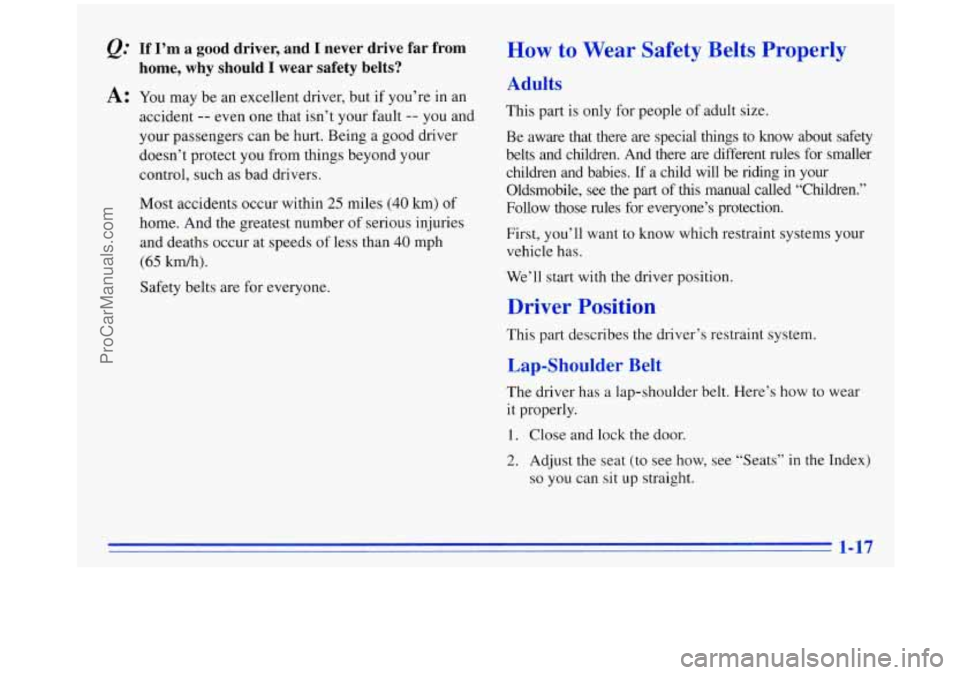
Q: If I’m a good driver, and I never drive far from
home, why should
I wear safety belts?
A: You may be an excellent driver, but if you’re in an
accident
-- even one that isn’t your fault -- you and
your passengers can be hurt. Being a good driver
doesn’t protect you from things beyond your
control, such as bad drivers.
Most accidents occur within
25 miles (40 km) of
home. And the greatest number of serious injuries
and deaths occur at speeds
of less than 40 mph
(65 km/h).
Safety belts are for everyone.
How to Wear Safety Belts Properly
Adults
This part is only for people of adult size.
Be aware that there are special things to know about safety
belts and children. And there are different rules
for smaller
children and babies.
If a child will be riding in your
Oldsmobile, see the
part of this manual called “Children.”
Follow those rules for everyone’s protection.
First, you’ll want to know which restraint systems your
vehicle
has.
We’ll start with the driver position.
Driver Position
This part describes the driver’s restraint system.
Lap-Shoulder Belt
The driver has a lap-shoulder belt. Here’s how to wear
it properly.
1. Close and lock the door.
2. Adjust the seat (to see how, see “Seats” in the Index)
so you can sit up straight.
ProCarManuals.com
Page 47 of 372
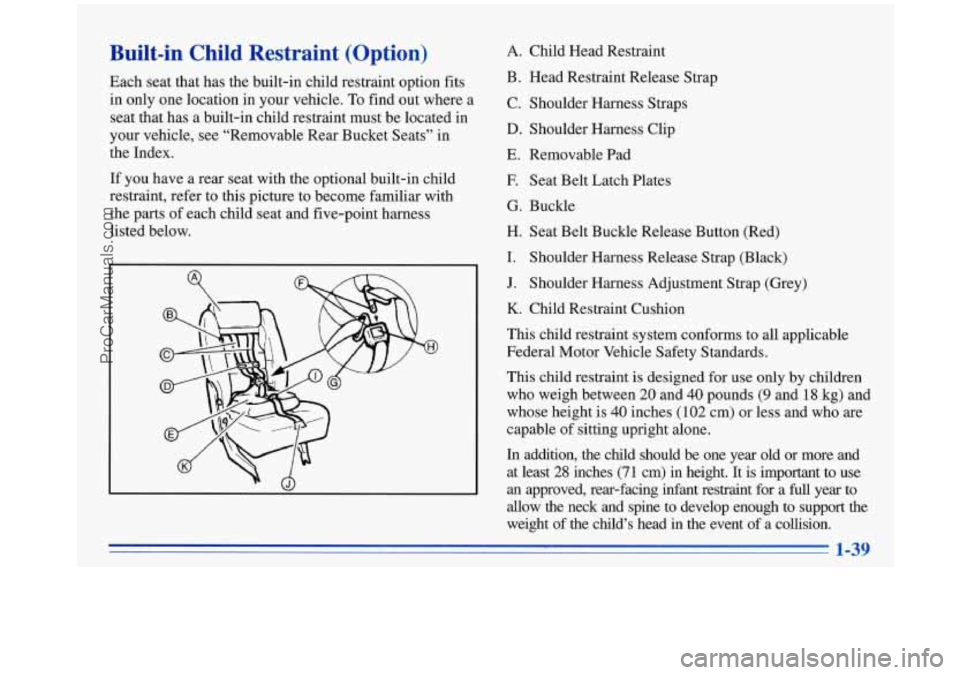
Built-in Child Restraint (Option)
Each seat that has the built-in child restraint option fits
in only one location in your vehicle.
To find out where a
seat that has
a built-in child restraint must be located in
your vehicle, see “Removable Rear Bucket Seats” in
the Index.
If you have a rear seat with the optional built-in child
restraint, refer to this picture to become familiar with,
the parts of each child seat and five-point harness
listed below. A.
Child Head Restraint
B. Head Restraint Release Strap
C. Shoulder Harness Straps
D. Shoulder Harness Clip
E. Removable Pad
F. Seat Belt Latch Plates
G. Buckle
H. Seat Belt Buckle Release Button (Red)
I. Shoulder Harness Release Strap (Black)
J. Shoulder Harness Adjustment Strap (Grey)
K. Child Restraint Cushion
This child restraint system conforms to all applicable
Federal Motor Vehicle Safety Standards.
This child restraint is designed for use only by children
who weigh between 20 and
40 pounds (9 and 18 kg) and
whose height is
40 inches (102 cm) or less and who are
capable of sitting upright alone.
In addition, ,the child should be one year old or more and
at least 28 inches
(71 cm) in height. It is important to use
an approved, rear-facing infant restraint for
a full year to
allow the neck and spine to develop enough to support the
weight of the child’s head
in the event of a collision.
1-39
ProCarManuals.com
Page 48 of 372
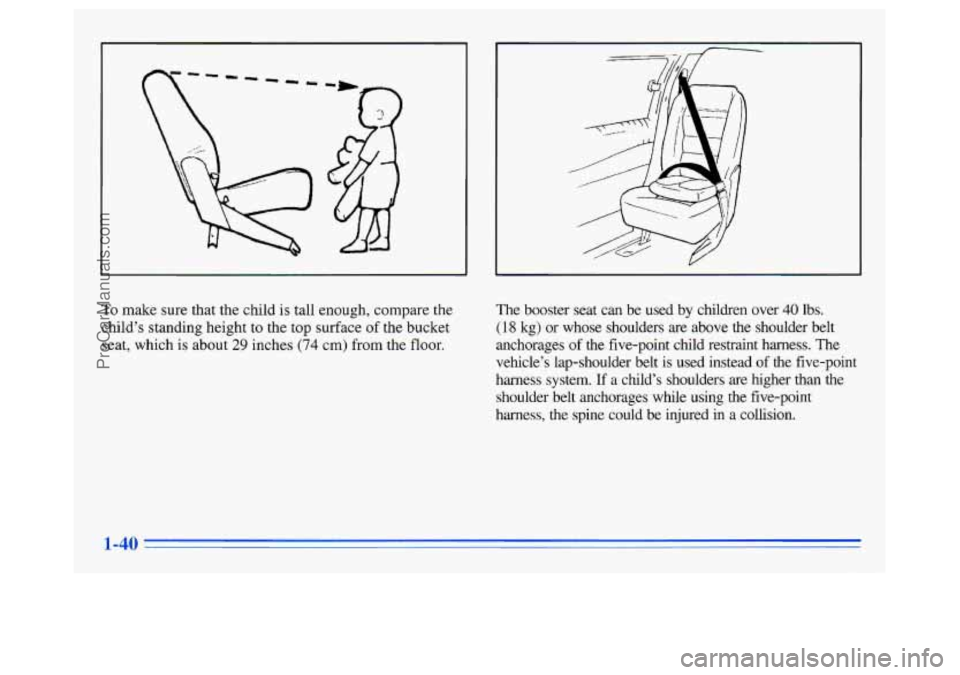
To make sure that the child is tall enough, compare the
child’s standing height to the top surface of the bucket
seat, which is about
29 inches (74 cm) from the floor. The
booster seat can be used by children over
40 lbs.
(1 8 kg) or whose shoulders are above the shoulder belt
anchorages
of the five-point child restraint harness. The
vehicle’s lap-shoulder belt is used instead
of the five-point
harness system. If
a child’s shoulders are higher than the
shoulder belt anchorages while using the five-point
harness, the spine could be injured in
a collision.
ProCarManuals.com
Page 49 of 372
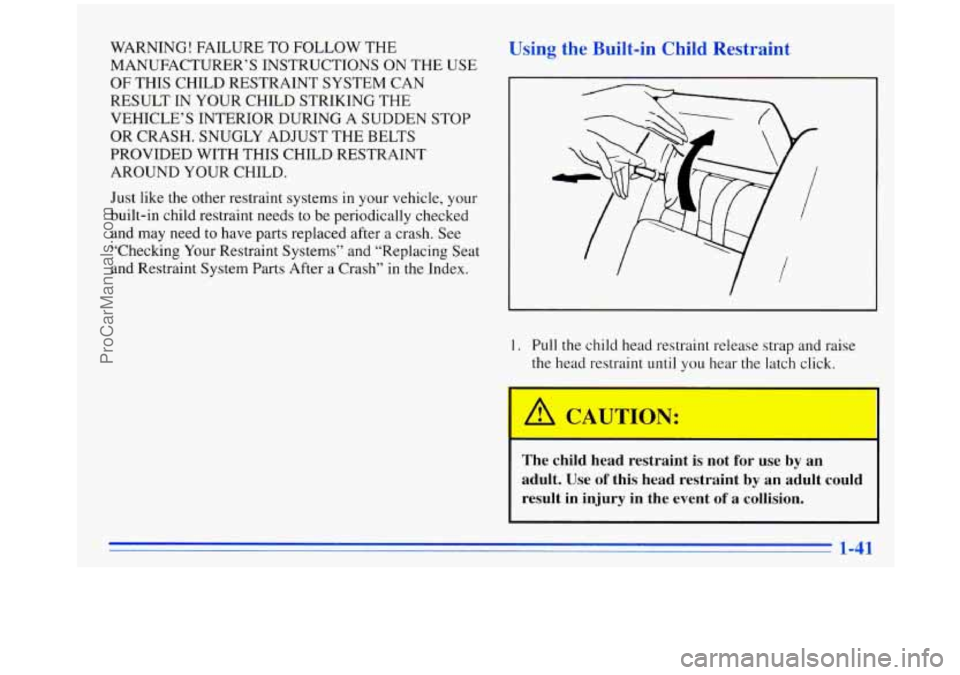
WARNING! FAILURE TO FOLLOW THE
MANUFACTURER’S INSTRUCTIONS ON THE
USE
OF THIS CHILD RESTRAINT SYSTEM CAN
RESULT IN YOUR CHILD STRIKING THE
VEHICLE’S INTERIOR DURING
A SUDDEN STOP
OR
CRASH. SNUGLY ADJUST THE BELTS
PROVIDED WITH THIS CHILD RESTRAINT AROUND YOUR CHILD.
Just like the other restraint systems in your vehicle, your
built-in child restraint needs to be periodically checked
and may need to have parts replaced after a crash. See
“Checking Your Restraint Systems’’ and “Replacing Seat
and Restraint System Parts After a Crash” in the Index.
Using the Built-in Child Restraint
I
1. Pull the child head restraint release strap and raise
the head restraint until you hear
the latch click.
The child head restraint is not for use by an
adult. Use of this head restraint by an adult could
result in injury in the event
of a collision.
1-41
ProCarManuals.com
Page 50 of 372
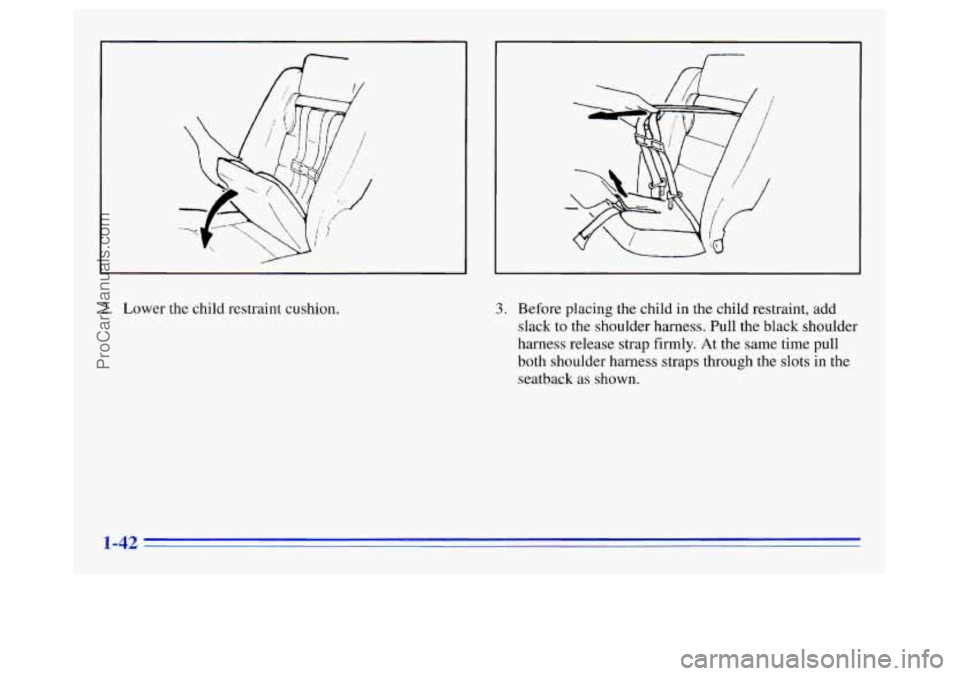
2. Lower the child restraint cushion. 3. Before placing the child in the child restraint, add
slack
to the shoulder harness. Pull the black shoulder
harness release strap firmly. At the same time pull
both shoulder harness straps through the slots in the
seatback as shown.
ProCarManuals.com
Page 51 of 372
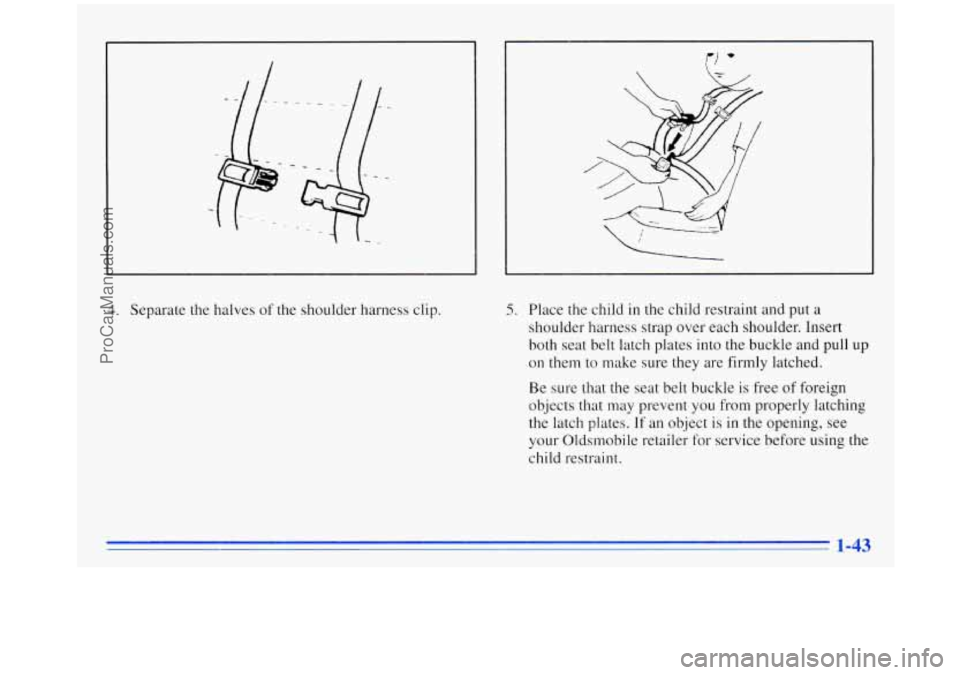
4. Separate the halves of the shoulder harness clip. 5. Place the child in the child restraint and put a
shoulder harness strap over each shoulder. Insert
both seat belt latch plates into the buckle and pull up
on them to make sure they are firmly latched.
Be sure that the seat belt buckle is free of foreign
objects that may prevent you from properly latching
the latch plates.
If an object is in the opening, see
your Oldmobile retailer for service before using the
child restraint.
ProCarManuals.com
Page 53 of 372
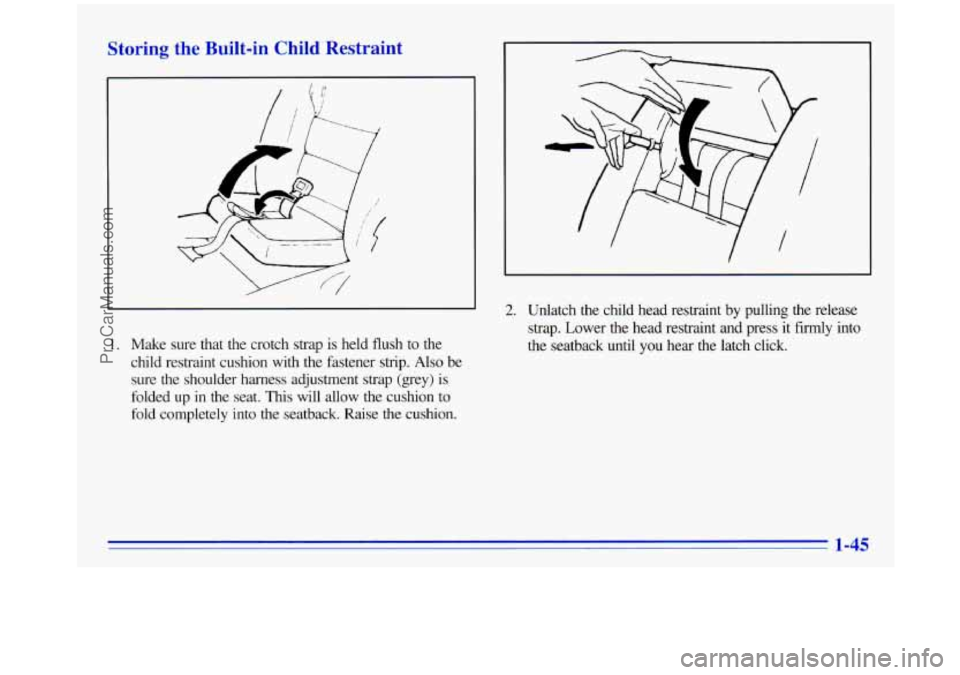
Storing the Built-in Child Restraint
1. Make sure that the crotch strap is held flush to the
child restraint cushion with the fastener strip.
Also be
sure the shoulder harness adjustment strap (grey) is
folded up
in the seat. This will allow the cushion to
fold completely into the seatback. Raise the cushion.
2. Unlatch the child head restraint by pulling the release
strap. Lower the head restraint
and press it firmly into
the seatback until you hear the latch click.
ProCarManuals.com
Page 54 of 372
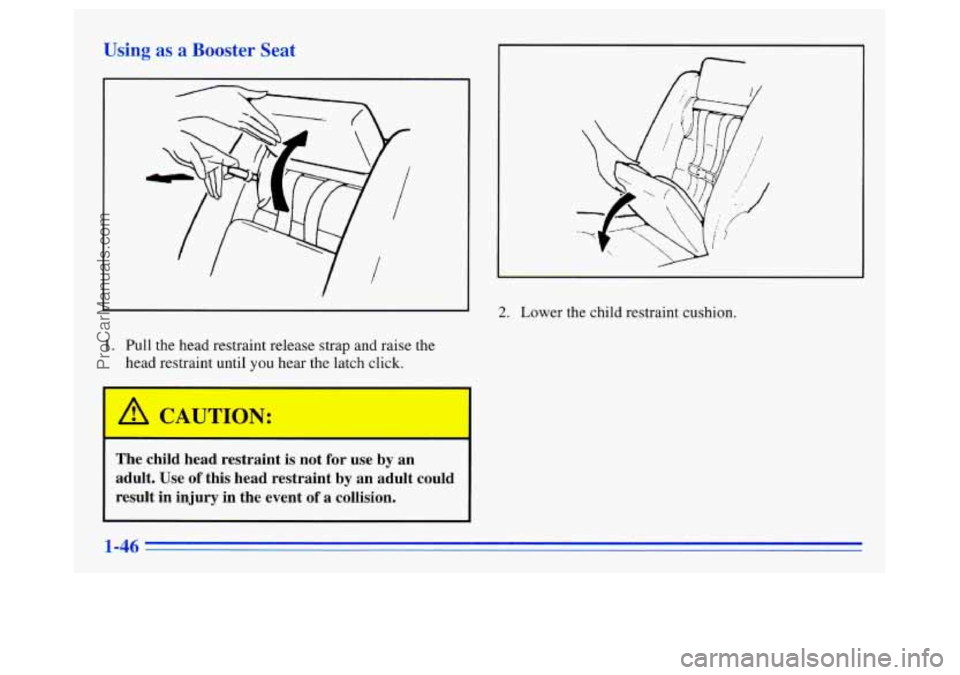
Using as a Booster Seat
I. Pull the head restraint release strap and raise the
head restraint until
you hear the latch click.
' A CAUTION:
The child head restraint is not for use by an
adult. Use
of this head restraint by an adult could
result in injury in the event
of a collision.
2. Lower the child restraint cushion.
1-46
ProCarManuals.com